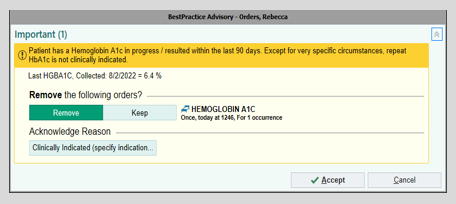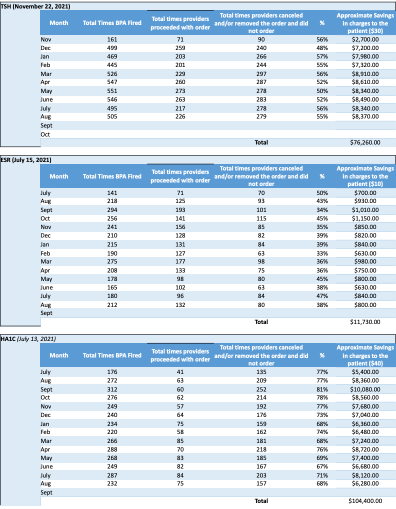Background: Over-testing leads to inflated direct and indirect costs of care. Re-ordering tests prior to a given recommended interval, whether secondary to a lack of awareness of information in the patient’s chart or a lack of knowledge of the given recommended interval, most often increases costs without benefiting patients. Best Practice Advisory (BPA) pop-ups and alarms can potentially be used to curb over-testing, but they can also burden providers in a healthcare system. With physician burnout reaching unprecedented levels, healthcare needs to account for the effects value-based interventions like BPAs can have on both workflow and wellness. We deployed BPA pop-ups in our Electronic Medical Record (EMR) to reduce unnecessary testing. We are assessing the efficacy of the pop-ups, including the impact of those pop-ups on providers.
Methods: Three labs were included in this pilot project: Thyroid Stimulating Hormone (TSH), Erythrocyte Sedimentation Rate (ESR), and Hemoglobin A1c (HbA1c). The BPA was active for new orders placed in both the inpatient setting and emergency department. It would fire if the provider reordered lab prior to the end of a recommended interval (e.g., TSH- 6 weeks, ESR- 1 week, HbA1c- 90 days) and informed the provider of three things: 1) The recommended time interval for reordering, 2) The most recent lab result, and 3) The date of that result. Each BPA was a soft stop—if the provider decided to proceed with the order, they had to provide a reason. The BPA would fire regardless of the most recent result’s context, provided it was within our system. We analyzed the number of times each BPA fired and whether the provider followed the recommendation. We are conducting a survey of providers in our health system to assess their impression of the pop-ups.
Results: Cost savings were calculated based on current Centers for Medicare & Medicaid Services (CMS) billing practices. The TSH BPA fired 4,744 times from 11/22/21-8/31/22, and providers canceled their TSH order 54% of the times the BPA fired. This percent reduction represents $72,260 in savings to the patient. The ESR BPA fired 2,983 times from 7/15/21-8/31/22, and providers canceled their ESR order 39% of the times the BPA fired. This percent reduction represents $11,730 in savings to the patient. The HbA1c BPA fired 3,569 times from 7/13/21-8/31/22, and providers canceled their order of HbA1c 73% of the times the BPA fired. This percent reduction represents $104,400 in savings to the patient. Our provider survey is in process.
Conclusions: Novel BPAs for labs commonly repeated too early reduce reordering and potentially reduce bills to patients and insurers. Our survey will help us understand if the additional burden placed on providers outweighs potential benefits.


